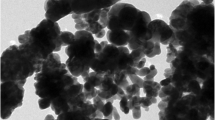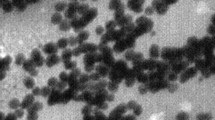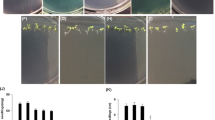Abstract
In this study, the toxic effect of copper oxide nanoparticles (CuONPs) at the physiological and molecular level was investigated in mung bean (Vigna radiata L.) plants. The seedlings were grown in half strength Murashige and Skoog medium supplemented with different concentrations of CuONPs (0, 20, 50, 100, 200 and 500 mg l−1) for 21 days under controlled growth conditions. Exposure to 200 and 500 mg l−1 of CuONPs significantly reduced shoot length and biomass. Significant reduction in root length and biomass was observed upon exposure to all concentrations of CuONPs. Retardation of primary and lateral root growth was observed upon exposure to different concentrations of CuONPs. At 100, 200 and 500 mg l−1 of CuONPs exposure, the total chlorophyll contents reduced significantly. Exposure to different concentrations of CuONPs has not resulted in any significant change in carotenoid contents. The proline content significantly increased upon exposure to 100, 200 and 500 mg l−1 of CuONPs. Significant increase in hydrogen peroxide content and lipid peroxidation was observed in roots upon exposure to 20, 50, 100, 200 and 500 mg l−1 of CuONPs. Histochemical staining with nitroblue tetrazolium and treatment with 3′-(p-hydroxyphenyl) fluorescein indicated a concentration-dependent increase in reactive oxygen species generation in roots. Exposure to CuONPs has resulted in excess lignification of roots cells as revealed by phloroglucionol-HCl staining. Gene expression analysis using real-time polymerase chain reaction showed modulations in the expression of CuZn superoxide dismutase, catalase and ascorbate peroxidase genes in roots of CuONPs exposed plants.







Similar content being viewed by others
References
Aruoja V, Dubourguier HC, Kasemets K, Kahru A (2009) Toxicity of nanoparticles of CuO, ZnO and TiO2 to microalgae Pseudokirchneriella subcapitata. Sci Total Environ 407:1461–1468
Asli S, Neumann PM (2009) Colloidal suspensions of clay or titanium dioxide nanoparticles can inhibit leaf growth and transpiration via physical effects on root water transport. Plant Cell Environ 32:577–584
Bates LS (1973) Rapid determination of free proline for water-stress studies. Plant Soil 39:205–207
Bowler C, Van Montagu M, Inzé D (1992) Superoxide dismutase and stress tolerance. Annu Rev Plant Physiol Plant Mol Biol 43:83–116
Brar SK, Verma M, Tyagi RD, Surampalli RY (2010) Engineered nanoparticles in waste water and waste water sludge-evidence and impacts. Waste Manage 30:504–520
Brennan T, Frenkel C (1977) Involvement of hydrogen peroxide in regulation of senescence in pear. Plant Physiol 59:411–416
Chen Y, Wang D, Zhu X, Zheng X, Feng L (2012) Long-term effects of copper nanoparticles on wastewater biological nutrient removal and N2O generation in the activated sludge process. Environ Sci Technol 46:12452–12458
Chiang HH, Dandekar AM (1995) Regulation of proline accumulation in Arabidopsis during development and in response to desiccation. Plant Cell Environ 18:1280–1290
Dimkpa CO, McLean JE, Latta DE, Manango´n E, Britt DW, Johnson WP, Boyanov MI, Anderson AJ (2012) CuO and ZnO nanoparticles: phytotoxicity, metal speciation, and induction of oxidative stress in sand-grown wheat. J Nanopart Res 14:1125
Fryer MJ, Oxborough K, Mullineaux PM, Baker NR (2002) Imaging of photooxidative stress responses in leaves. J Ex Bot 53:1249–1254
Gomes T, Pinheiro JP, Cancio I, Pereira CG, Cardoso C, Bebianno MJ (2010) Effects of copper nanoparticles exposure in the mussel Mytilus galloprovincialis. Environ Sci Technol 45:9356–9362
Griffitt RJ, Weil R, Hyndman KA, Denslow ND, Powers K, Taylor D, Barber DS (2007) Exposure to copper nanoparticles causes gill injury and acute lethality in zebrafish (Danio rerio). Environ Sci Technol 41:8178–8186
Heath RL, Packer L (1968) Photoperoxidation in isolated chloroplasts. I. Kinetics and stochiometry of fatty acid peroxidation. Arch Biochem Biophys 125:189–198
Hu X, Cook S, Wang P, Hwang HM (2009) In vitro evaluation of cytotoxicity of engineered metal oxide nanoparticles. Sci Total Environ 407:3070–3072
Karlsson HL, Cronholm P, Gustafsson J, Möller L (2008) Copper oxide nanoparticles are highly toxic: a comparison between metal oxide nanoparticles and carbon nanotubes. Chem Res Toxicol 21:1726–1732
Kováčik J, Grúz J, Klejdus B, Štorka F, Marchiosid R, Ferrarese-Filhod O (2010) Lignification and related parameters in copper-exposed Matricaria chamomilla roots: role of H2O2 and NO in this process. Plant Sci 179:383–389
Kwasniewskia M, Chwialkowska K, Kwasniewska J, Kusak J, Siwinski K, Szarejko I (2013) Accumulation of peroxidase-related reactive oxygen species in trichoblasts correlates with root hair initiation in barley. J Plant Physiol 170:185–195
Lee WM, An YJ, Yoon H, Kweon HS (2008) Toxicity and bioavailability of copper nanoparticles to the terrestrial plants Mung bean (Phaseolus radiatus) and Wheat (Triticum aestivum): plant agar test for water-insoluble nanoparticles. Environ Toxicol Chem 27:1915–1921
Lee CW, Mahendra S, Zodrow KLID, Tsai YC, Braam J, Alvarez PJJ (2010) Developmental phytotoxicity of metal oxide nanoparticles to Arabidopsis thaliana. Environ Toxicol Chem 29:669–675
Lequeux H, Hermans C, Lutts S, Nathalie V (2010) Response to copper excess in Arabidopsis thaliana: impact on the root system architecture, hormone distribution, lignin accumulation and mineral profile. Plant Physiol Biochem 48:673–682
Lichtenthaler HK (1987) Chlorophylls and carotenoids: pigments of photosynthetic biomembranes. In: Lester Packer RD (ed) Methods in enzymology, vol 148. Academic Press, Waltham, pp 350–382
Lin D, Xing B (2008) Root uptake and phytotoxicity of ZnO nanoparticles. Environ Sci Technol 42:5580–5585
Lin CC, Chen LM, Liu ZH (2005) Rapid effect of copper on lignin biosynthesis in soybean roots. Plant Sci 168:855–861
Lin CH, Peng PH, Ko CY, Markhart AH, Lin TY (2012) Characterization of a novel Y2 K-type dehydrin VrDhn1 from Vigna radiata. Plant Cell Physiol 53:930–942
Ma C, Chhikara S, Xing B, Musante C, White JC, Dhankher OP (2013) Physiological and molecular response of Arabidopsis thaliana (L.) to nanoparticle cerium and indium oxide exposure. ACS Sus Chem Eng 1:768–778
Matysik J, Alia Bhalu B, Mohanty P (2002) Molecular mechanism of quenching of reactive oxygen species by proline under stress in plants. Curr Sci 82:525–532
Melegari SP, Perreault F, Popovic RHRC, Radovan Matias WG (2013) Evaluation of toxicity and oxidative stress induced by copper oxide nanoparticles in the green alga Chlamydomonas reinhardtii. Aquat Toxicol 142–143:431–440
Nair PMG, Chung IM (2014) Impact of copper oxide nanoparticles exposure on Arabidopsis thaliana growth, root system development, root lignificaion and molecular level changes. Environ Sci Pollut Res. doi:10.1007/s11356-014-3210-3
OECD (organization for economic cooperation and development) (1984) Terrestrial plants, growth test. OECD guidelines for testing of chemicals. No. 208. OECD, Paris
Oleszczuk P, Josko I, Xing BS (2011) The toxicity to plants of the sewage sludges containing multiwalled carbon nanotubes. J Hazard Mater 186:436–442
Poborilova Z, Opatrilova R, Babula P (2013) Toxicity of aluminium oxide nanoparticles demonstrated using a BY-2 plant cell suspension culture model. Environ Exp Bot 91:1–11
Rico CM, Majumdar S, Duarte-Gardea M, Peralta-Videa JR, Gardea-Torresdey JL (2011) Interaction of nanoparticles with edible plants and their possible implications in the food chain. J Agric Food Chem 27:3485–3498
Rogers LA, Dubos C, Surman C, Willment J, Cullis IF, Mansfield SD, Campbell MM (2005) Comparison of lignin deposition in three ectopic lignification mutants. New Phytol 168:123–140
Shaw AK, Hossain Z (2013) Impact of nano-CuO stress on rice (Oryza sativa L.) seedlings. Chemosphere 93:906–915
Shaw AK, Ghosh S, Kalaji HM, Bosa K, Brestic M, Zivcak M, Hossain Z (2014) Nano-CuO stress induced modulation of antioxidative defense and photosynthetic performance of syrian barley (Hordeum vulgare L.). Environ Exp Bot 102:37–47
Shi J, Peng C, Yang Y, Yang J, Zhang H, Yuan X, Chen Y, Hu T (2014) Phytotoxicity and accumulation of copper oxide nanoparticles to the Cu-tolerant plant Elsholtzia splendens. Nanotoxicol 8:179–188
Wang Z, Xie X, Zhao J, Liu X, Feng W, White JC, Xing B (2012) Xylem and phloem based transport of CuO nanoparticles in maize (Zea mays L.). Environ Sci Technol 46:4434–4441
Yoon KY, Byeon JH, Park JH, Hwang J (2007) Susceptibility constants of Escherichia coli and Bacillus subtilis to silver and copper nanoparticles. Sci Total Environ 373:572–575
Young AJ (1991) The protective role of carotenoids in higher plants. Physiol Plant 83:702–708
Acknowledgments
This paper was supported by the KU Research Professor Program of Konkuk University, Seoul, South Korea to Prakash M. Gopalakrishnan Nair. This research was supported by Basic Science Research Program through the National Research Foundation of Korea (NRF) funded by the Ministry of Science, ICT and Future Planning (2014R1A2A2A01002202).
Conflict of interest
The authors declare no conflict of interest.
Author information
Authors and Affiliations
Corresponding author
Additional information
Communicated by J. Kovacik.
Rights and permissions
About this article
Cite this article
Gopalakrishnan Nair, P.M., Kim, SH. & Chung, I.M. Copper oxide nanoparticle toxicity in mung bean (Vigna radiata L.) seedlings: physiological and molecular level responses of in vitro grown plants. Acta Physiol Plant 36, 2947–2958 (2014). https://doi.org/10.1007/s11738-014-1667-9
Received:
Revised:
Accepted:
Published:
Issue Date:
DOI: https://doi.org/10.1007/s11738-014-1667-9




